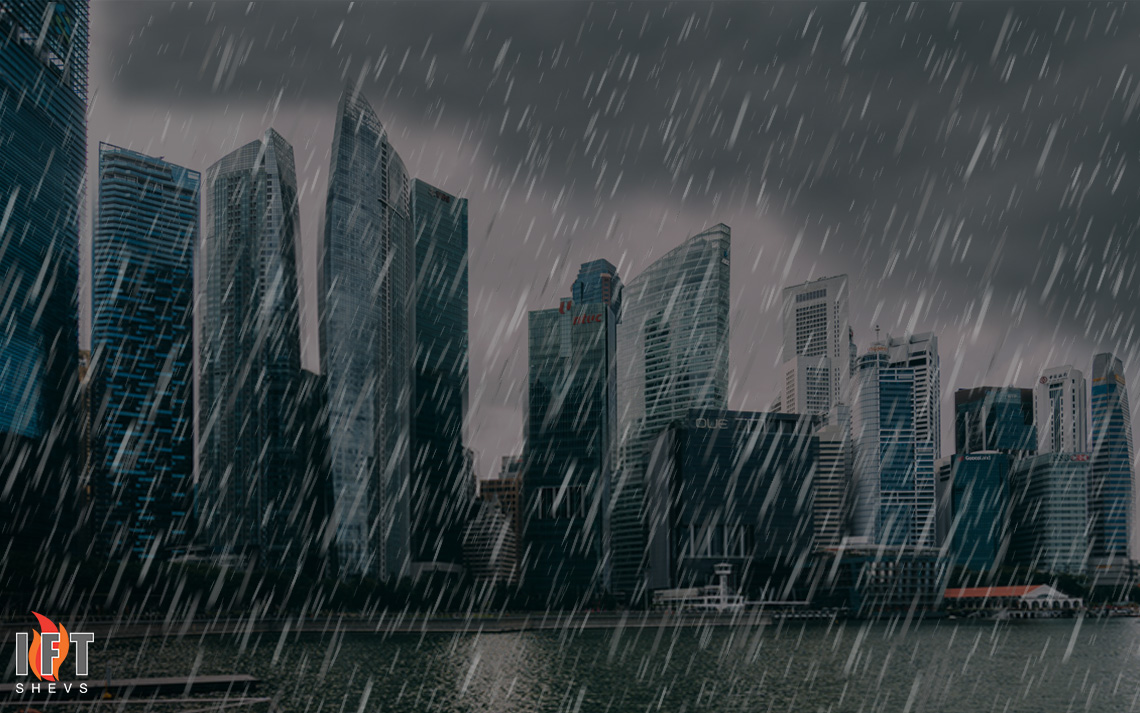
For most buildings, natural openings along the common corridors are often designed with a dual purpose;
- To provide natural ventilation in the corridors to maintain thermal comfort for day-to-day use by occupants.
- To disperse smoke from the corridors to external to maintain tenable conditions for escape by occupants during a fire situation.
However, on a rainy day, wind-driven rain ingress into these corridors through the natural openings can cause inconvenience and safety for occupants. Mitigating features such as rain screens or canopies are commonly added to these natural openings to block off the wind-driven rain into the corridors.
As a result, these rain screens will reduce the effectiveness of the natural ventilation required for day-to-day ventilation as well as for smoke dispersal during a fire situation.
In order to derive a well-balanced design for the common corridors that will allow effective smoke dispersal from circulation spaces during a fire and prevent wind-driven rain ingress on rainy days, appropriate fire engineering assessment and wind-driven rain simulation can be used to validate the effectiveness of the smoke dispersal and wind-driven rain ingress holistically.
At SHEVS IFT, we have the relevant experience, accredited engineering tools and softwares to verify and endorse on the effectiveness of any corridor design in terms of the smoke dispersal, day-to-day natural ventilation as well as the wind-driven rain ingress.
What is Wind-Driven Rain?
Wind-driven rain is a form of rainfall caused by a forceful drive of wind that pushes rainwater into a building. The wind creates a pressure differential between the air outside and the air inside the building, which forces rainwater through any openings in the structure, typically dampening the corridors of buildings.
To protect against wind-driven rain, buildings should be designed with proper ventilation and drainage to allow the water to escape. By taking these precautions, buildings can minimise the risk of occupant safety in the event of severe weather.
Preventing Wind-Driven Rain and Dispersing Smoke with Rainscreens
The effects of wind-driven rain can be avoided by implementing structural formations that have the ability to deflect rain and drain out water effectively. However, some of these solutions do not allow the easy dispersal of smoke during a fire and may trap smoke within buildings with or without rainfall. One solution to wind-driven rain and smoke is the use of rainscreens.
No Rain Screen, Wind-Driven Rain Ingress
In this illustration, the corridor is wet due to wind-driven rain and the absence of a rainscreen. Rainwater can cause damage to the building structure and even pose a safety risk to occupants of the building.
Impact of Rain Screen Perforation on Wind-Driven Rain and Fire Safety for Escape Corridor
In order to create a balanced solution for wind-driven rain and fire safety for escape corridors, we at SHEVS IFT conducted 2 case studies;
- Rain Screen with Inadequate Perforation
- Rain Screen with Optimal Perforation
Rain Screen with Inadequate Perforation, No Wind-Driven Rain Ingress
In this illustration, the corridors are dry on a rainy day due to the presence of a typical rainscreen.
Rain Screen with Inadequate Perforation, Smoke Logging In The Corridor
In the event of a fire, a typical rainscreen will hinder the dispersion of smoke. This causes smoke to gather along the corridors, jeopardising the safety of occupants during evacuation.
Rain Screen with Optimal Perforation, No Wind-Driven Rain Ingress
In this illustration, the optimised rainscreen with improved porosity prevents wind-driven rain from entering the corridors.
Rain Screen with Optimal Perforation, No Smoke Logging In The Corridor
During a fire, smoke can be dispersed easily, this will not cause a smoke log condition at the corridors, which is safe for occupants. The porosity of the rainscreen had been optimised to meet both wind-driven rain and fire safety requirements, which is the ideal option for building safety.
Fire safety engineering and wind-driven rain simulations are vital if building owners wish to design a building structure that helps to keep out wind-driven rain while ensuring fire safety.
At SHEVS IFT, we carry out Wind-Driven Rain Simulations and Smoke Simulations by using Computational Fluid Dynamics (CFD) modelling to determine the best solution in addressing both rainfall and smoke issues. Our design solutions aim to strike an ideal balance between rain ingress and smoke dispersal by minimising the entry of wind-driven rain while maintaining tenable conditions for your building during fire emergencies.
Want to learn more about fire safety engineering or wind-driven rain simulations in Singapore? Contact us today to discover more safe building designs.